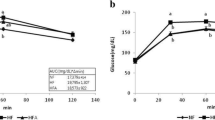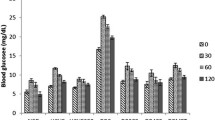Abstract
Salicornia herbacea L. (Chenopodiaceae) has been used as a seasoned vegetable by living in coastal areas.S. herbacea (SH) has been demonstrated to stimulate cytokine production, nitric oxide release, and to show anti-oxidative effect. In a series of investigations to develop potential anti-diabetic and/or anti-hyperlipidemic agents from Korean indigenous plants, 50% ethanol extract ofSalicomia herbacea was found to prevent the onset of the hyperglycemia and hyperlipidemia induced by high fat diet in ICR mice. At 6 week old, the ICR mice were randomly divided into five groups; two control and three treatment groups. The control mice were to receive either a regular diet (RD) or high-fat diet (HFD), and the treatment groups were fed a high fat diet with either 350 mg/kg, 700 mg/kg of SH (SH350 and SH700) or 250 mg/kg of metformin (MT250) for a 10-week period. SH not only reduced body weight but also corrected associated hyperglycemia and hyperlipidemia in a dose dependent manner. SH exerted beneficial effects on the plasma glucose and lipid homeostasis possibly ascribed to its specific effects on lipogenesis related genes (SREBP1a, FAS GAPT), and PEPCK, glucose 6-phosphatase gene expressions in liver. Ethanol extract ofS. herbacea has potential as a preventive agent for type 2 diabetes (and possibly hyperlipidemia) and deserves future clinical trial.
Similar content being viewed by others
References
Astrup, A., Healthy lifestyles in Europe: prevention of obesity and type II diabetes by diet and physical activity.Public Health Nutr., 4, 499–515 (2001).
Attele, A. S., Wu, J. A., and Yuan, C. S., Multiple pharmacological effects of ginseng.Biochem. Pharmacol., 58, 1685–1693 (1999).
Cavaghan, M. K., Ehrmann, D. A., and Polonsky, K. S., Interactions between insulin resistance and insulin secretion in the development of glucose intolerance.J. Clin. Invest., 106, 329–333 (2000).
Chomczynski, P. and Sacchi, N., Single-step method of RNA isolation by acid guanidinium thiocyanate-phenol-chloroform extraction.Anal. Biochem., 162, 156–159 (1987).
Cohen, P., Zhao, C., Cai, X., Montez, J. M., Rohani, S. C., Feinstein, P., Mombaerts, P., and Friedman, J. M., Selective deletion of leptin receptor in neurons leads to obesity.J. Clin. Invest., 108, 1113–1121 (2001).
Davies, G. F., Khandelwal, R. L., Wu, L., Juurlink, B. H., and Roesler, W. J., Inhibition of phosphoenolpyruvate carboxykinase (PEPCK) gene expression by troglitazone: a peroxisome proliferator-activated receptor-gamma (PPARgamma)-independent, antioxidant-related mechanism.Biochem. Pharmacol., 62, 1071–1079 (2001).
Han, S. K. and Kim, S. M., Antioxidative effect of Salicornia herbacea L. grown in closed sea beach.J. Korean Food Sci. Nutr., 32, 207–210 (2003).
Im, S. A., Kim, G. W., and Lee, C. K., Immunomodulatory activity ofSalicornia herbaceae L. components.Nat. Prod. Sci., 9, 273–277 (2003).
Inzucchi, S. E., Oral antihyperglycemic therapy for type 2 diabetes: scientific review.J. Am. Med. Assoc., 287, 360–372 (2002).
Kim, C. S. and Song, T. G., Ecological studies on the halophyte communities at western and southern coasts in Korea.Kor. J. Eco., 6, 167–176 (1983).
Lee, Y. N., Flora of Korea. Kyohak Publishing Co., Seoul, pp. 144 (1997).
Lee, Y. S., Lee, S., Lee, H. S., Kim, B.-K., and Ohuchi, K., Inhibitory effects of 3-O-β-d-glucoside from Salicornia herbecea on rat lens aldose reductase and sorbitol accumulation in streptozotocin-induced diabetic rat tissues.Biol. Pharm. Bull., 28(5), 916–918 (2005).
Lin, H. Z., Yang, S. Q., Kujhada, F., Ronnet, G., and Diehl, A. M., Metformin reverses nonalcoholic fatty liver disease in obese leptin-deficient mice.Nature Medicine 6, 998–1003 (2000).
Manco, M., Calvani, M., and Mingrone, G., Effects of dietary fatty acids on insulin sensitivity and secretion.Diabetes Obes. Metab., 6, 402–413 (2004).
Matthews, D. R., Hosker, J. P., Rudenky, A. S., Naylor, B. A., Treacher, D. F., and Turner, R. C., Homeostasis model assessment: insulin resistance and beta-cell function from fasting plasma glucose and insulin concentration in man.Diabetologia 28, 412–419 (1985).
Mithieux, G., New knowledge regarding glucose-6-phosphatase gene and protein and their roles in the regulation of glucose metabolism.Eur. J. Endocrinol., 136, 137–145 (1997).
Moller, D. E., New drug targets for type 2 diabetes and the metabolic syndrome.Nature (Lond.), 414, 821–827 (2001).
Sone, H., Suzuki, H., Takahashi, A., and Yamada, N., Disease model: hyperinsulinemia and insulin resistance. Part A-targeted disruption of insulin signaling or glucose transport.Trends Mol. Med., 7, 320–322 (2001).
Surwit, R. S., Kuhn, C. M., Cochrane, C., McCubbin, J. A., and Feinglos, M. N., Diet-induced type II diabetes in C57BL/6J mice.Diabetes, 37, 1163–1167 (1988).
The Diabetes Control and Complication Trial Research Group. The effect of intensive treatment of diabetes in the development and progression of long term complications in insulin-dependent diabetes mellitus.New Engl. J. Med., 329, 977–986 (1993).
Thuresson, E. R., Inhibition of glycerol-3-phosphate acyltrans-ferase as a potential treatment for insulin resistance and type 2 diabetes.Curr. Opin. Invest. Drugs 5, 411–418 (2004).
Trinder, P., Determination of blood glucose using an oxidase-peroxidase system with a non-carcinogenic chromogen.J. Clin. Pathol., 22, 158–161 (1969).
Thupari, J. N., Kim, E. K., Moran, T. H., Ronnett, G. V., and Kuhajda, F. P., Chronic C75 treatment of diet-induced obese mice increases fat oxidation and reduces food intake to reduce adipose mass.Am. J. Physiol-Endoc M., 287, 97–104 (2004).
UK prospective Diabetes Study Group (UKPDS), Intensive blood glucose control with sulphonylureas or insulin compared with conventional treatment and risk of complications in patients with type 2 diabetes (UKPSD 33).Lancet, 352, 837–853 (1998).
Yun, S. N., Moon, S. J., Ko, S. K., Im, B. O., and Chung, S. H., Wild ginseng prevents the onset of high-fat diet induced hyperglycemia and obesity in ICR mice.Arch. Pharm. Res., 27, 790–796 (2004).
Zhang, Y., Proenca, R., Maffei, M., Barone, M., Leopold, L., and Friedman, J. M., Positional cloning of the mouse obese gene and its human homologue.Nature, 372, 425–432 (1994).
Author information
Authors and Affiliations
Corresponding author
Rights and permissions
About this article
Cite this article
Park, S.H., Ko, S.K., Choi, J.G. et al. Salicornia herbacea prevents high fat diet-induced hyperglycemia and hyperlipidemia in ICR mice. Arch Pharm Res 29, 256–264 (2006). https://doi.org/10.1007/BF02969402
Received:
Issue Date:
DOI: https://doi.org/10.1007/BF02969402




